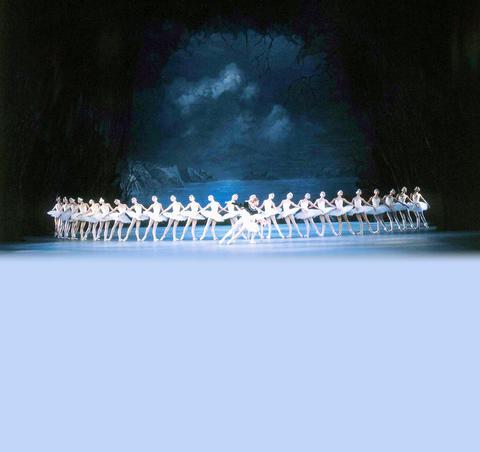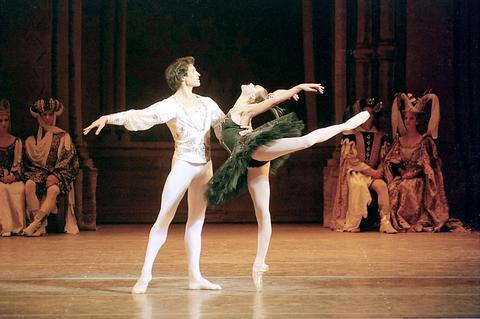Did the Kirov Ballet live up to its gilded reputation? Taking a cue from Tim Rice's lyrics for Evita one would have to say: "Yes! And no and yes and no and ?" Well, mostly yes.
There were some spectacular performances -- one of which was enough to bring tears to your eyes -- the technical proficiency of the dancers was amazing, the corps de ballet looked beautiful and graceful and the Kirov Orchestra was in fine form. All too often, however, the emotional connection between the dancers and the music or the story appeared to have been discarded in the drive for style over substance.

But the audiences appeared pleased with the productions and the National Theater looked close to being sold out the two nights that were reviewed.

There was definitely a festive air for the gala opening last week. There was also a lot of security for the president and other top officials who were invited to attend. The evening began with Mikhail Fokine's Chopinana (Les Sylphids) to the music of Frederic Chopin. It's a lovely little ballet and the Kirov's performance was very soft and musical.
This was followed by five short pieces: Le Spectre de la Rose, Talisman, The Dying Swan, Le Coirsaire Pas De Deux and Polovtsian Dances.
Le Spectre de la Rose is unusual in that it is the male dancer who is the focus of the piece, from the moment he makes his grand jete entrance. When people talk of the amazing arms of the Kirov's dancers, it is usually the women they are talking about. Igor Kolb's arms were amazing -- liquid and languid and hardly real.
Talisman, with Irma Nioradze and Mikhail Lobukhin got off to an uneven start, but picked up speed and finished strongly. This pas de deux is not seen that often. It is all that is left from a ballet by Marius Petipa created in 1889 called Le Talisman.
The highlight of the evening was Uliana Lopatkina as The Dying Swan. She was unbelievable: Six minutes of heartbreaking fluttering, yearning arms, tiny stuttering steps, and deeply arching body. Her arms -- at times floating through the air, at other times bending backwards at amazing angles -- looked so unlike a normal human being's that you would almost swear they really were wings. A last stretch back, a broken wing hanging in the air, and the swan folded herself over her legs, bowed her head and moved no more. It was a performance that could have wrung tears from a stone.
Lopatkina's performance was a hard one to follow, but Alina Somova and Leonid Sarafanov managed a flashy Le Corisaire Pas De Deux. His leaps and spins were right on the mark every time and she nailed her 32 foutettes as if they were nothing. The fast pacing of this piece set the stage for Fokine's Polovtsian Dances, a rousing one-act ballet from the opera Prince Igor by Alexander Borodin. The bare-chested nomadic warriors and exotic dancing girls were ably led by Islom Baimuradow, all fierceness and flash.
The gala finished with the Paquita Grand Pas, which, with its multitude of dainty solos and variations, was a very polished and elegant end to an enjoyable evening and triggered several rousing rounds of applause for the company.
On Saturday night the loudest applause was for the dancers whose roles are unique to Russian productions of Swan Lake: Andrey Ivanov as the jester and Ilya Kuznetsov as the evil magician, Von Rothbart. Ivanov, a short dancer with bulky thighs, has some of the fastest pirouettes ever seen. Fast, confident, and cheeky; just what a good jester ought to be.
Kuznetsov, dressed in black leotard and tights, with small silver-tipped wings and headdress, was made up to look like a very evil owl. He exuded menace. He is a great jumper, though one got the impression that some of his jetes had to be reined in because the depth of the National Theater's stage is not what the Kirov is used to back in St. Petersburg.
The corps de ballet was a stunning flock of 26 swans with pliant backs and lovely arms that seemed to be so light they couldn't be real. Their arms didn't just move through the air, they caressed it, sifting each mote through their fingers. The four Signets -- Svetlana Ivanova, Elena Yshkouskaya, Yana Khaldina and Elena Sheshina -- were a joy to watch. Very crisp and clean, not a feather out of place, they whipped through their piece if anything just a little too fast. You didn't want it to end.
Sofia Gumerova and Kolb, however, were a bit disappointing as the leads. Gumerova is a tall, regal looking dancer and she moves beautifully as Odette/Odile, combining a sense of strength with one of fragility. But as the White Swan, Odette, Gumerova was all turned inwards, remote.
Kolb is a very accomplished classic dancer, though he looked more at home as the fun-loving prince in Act I than he did as the smitten lover in the rest of the ballet. But there didn't seem to be any spark between him and Gumerova and hardly even much eye contact.
As Odile, the Black Swan, Gumerova was in complete control -- smiling all the while -- even through her 32 foutettes, which were rather sloppy and for a moment in doubt of being completed.
As for the Kirov's happy ending, with the prince tearing off one of Rothbart's wings and killing him, freeing Odette from the curse, it appears to be a rather abrupt and unsatisfactory conclusion.
Not that suicide should be promoted as a way out of an unhappy love affair, but Peter Tchaikovsky's music for this scene calls for more theatrics than a prince waving a piece of cloth around before dashing back to pose with his swan princess.
Hopefully, the younger Kirov dancers will learn that along with all that wonderful technique, you need to spend some time to show some emotion.

May 11 to May 18 The original Taichung Railway Station was long thought to have been completely razed. Opening on May 15, 1905, the one-story wooden structure soon outgrew its purpose and was replaced in 1917 by a grandiose, Western-style station. During construction on the third-generation station in 2017, workers discovered the service pit for the original station’s locomotive depot. A year later, a small wooden building on site was determined by historians to be the first stationmaster’s office, built around 1908. With these findings, the Taichung Railway Station Cultural Park now boasts that it has

The latest Formosa poll released at the end of last month shows confidence in President William Lai (賴清德) plunged 8.1 percent, while satisfaction with the Lai administration fared worse with a drop of 8.5 percent. Those lacking confidence in Lai jumped by 6 percent and dissatisfaction in his administration spiked up 6.7 percent. Confidence in Lai is still strong at 48.6 percent, compared to 43 percent lacking confidence — but this is his worst result overall since he took office. For the first time, dissatisfaction with his administration surpassed satisfaction, 47.3 to 47.1 percent. Though statistically a tie, for most

Six weeks before I embarked on a research mission in Kyoto, I was sitting alone at a bar counter in Melbourne. Next to me, a woman was bragging loudly to a friend: She, too, was heading to Kyoto, I quickly discerned. Except her trip was in four months. And she’d just pulled an all-nighter booking restaurant reservations. As I snooped on the conversation, I broke out in a sweat, panicking because I’d yet to secure a single table. Then I remembered: Eating well in Japan is absolutely not something to lose sleep over. It’s true that the best-known institutions book up faster

In February of this year the Taipei Times reported on the visit of Lienchiang County Commissioner Wang Chung-ming (王忠銘) of the Chinese Nationalist Party (KMT) and a delegation to a lantern festival in Fuzhou’s Mawei District in Fujian Province. “Today, Mawei and Matsu jointly marked the lantern festival,” Wang was quoted as saying, adding that both sides “being of one people,” is a cause for joy. Wang was passing around a common claim of officials of the People’s Republic of China (PRC) and the PRC’s allies and supporters in Taiwan — KMT and the Taiwan People’s Party — and elsewhere: Taiwan and